Research Spotlights
In honor of Georgia Southern’s Research Month, The Office of Research worked with students and faculty around campus to publish “Research Spotlights.” These spotlights showcase many different awesome research efforts that are happening right here at Georgia Southern University! Don’t forget to check out the Student Research Symposiums on April 18th at the Nessmith-Lane Conference Center on the Statesboro Campus and April 24-25th at the Student Union on the Armstrong Campus.
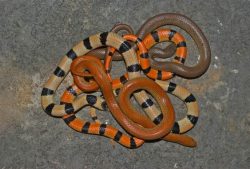 Christian L Cox, Assistant Professor, Department of Biology
Christian L Cox, Assistant Professor, Department of Biology
I am an integrative evolutionary biologist who uses genetics, ecology, physiology, and transcriptomics to study the evolution of functional and genetic diversity at multiple biological scales. Phenotypic and functional diversity are the raw material acted upon by natural selection, and to the extent that they are controlled by genomic variation, represent the potential for evolutionary adaptation. Research in my laboratory is focused on studying the selective forces acting upon functional diversity and the genomic and transcriptomic mechanisms regulating functional diversity. Current work in my laboratory spans four major research programs. First, we study integrative physiology and the evolution of sexual size dimorphism. A central goal of evolutionary biology is to explain how complex phenotypes can diverge between the sexes despite them sharing an autosomal genome. My research addresses this question by characterizing differences between the sexes and how selection acts upon these traits. Second, we study the evolutionary dynamics of antipredator coloration. Color has long been the focus of research on phenotypic diversity and trait evolution because of clear fitness benefits for reproduction (sexual selection) and survival (crypsis, aposematism, mimicry). My research seeks to understand how selection acts upon color in mimicry complexes, the temporal dynamics of color evolution, the genomic basis of color polymorphism and selective dynamics in color pattern genes. Third, we study adaptation to the biophysical environment. All organisms must interact with the physical environment, and so must be adapted to their physical environment. My integrative research uses field ecology, physiology, genomics and macroevolutionary analyses to study adaptation to the physical environment. Finally, we study the pattern and process of evolutionary diversification. My laboratory uses genetics, morphology, and transcriptomics to study the mechanisms facilitating or constraining diversification in a macroevoluationary context. The ultimate goal of my integrative research program is to understand evolutionary drivers of phenotypic and functional diversity across the tree of life.
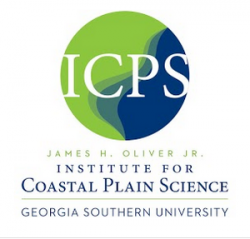 REU Site – Interdisciplinary Research Experiences in Coastal Plain Science
REU Site – Interdisciplinary Research Experiences in Coastal Plain Science
The proposed REU site will offer a 10-week summer program for 10 students each year from 2018-2020.
The unifying theme will be to better understand the impacts of global climate change stressors on organisms and ecosystems of the Atlantic Coastal Plain with the ultimate goal of engaging undergraduates in research and professional development activities that promote an understanding of the unique physical and biological resources occurring in this geographic region as well as their sustainable use and management. This goal will be achieved by having students participate in hands-on research guided by faculty mentors, as well as in professional development workshops targeting general and conceptual knowledge in the ecology and geology of the coastal plain, scientific communication skills (oral and written), techniques for locating and evaluating primary literature, and ethical practices in science. The desired outcome of these activities will be to nurture an intense interest and appreciation for the scientific process and increase the competitiveness of participants for future graduate opportunities and consequently careers in science. The focus demographic will be 1st and 2nd year undergraduate students attending institutions in the southeastern U.S. where research opportunities may be more limited, such as at 2-year colleges and primarily undergraduate institutions. The program will emphasize recruitment of students from traditionally underrepresented groups in the natural sciences (e.g., African Americans, Hispanic/Latinos, Native Americans, 1st Generation College Students, and students with disabilities). Furthermore, GS’s award-winning program in military science and proximity to large military installations will provide the opportunity to target current cadets and disabled veterans who are returning to complete undergraduate degrees in STEM. The program’s mission will be to prepare a core of scientists possessing an intimate understanding of the complex environmental issues facing the sustainable use and management of the natural resources of the southeastern US. Further, by targeting demographic groups comprising a large portion of the population in the region, it is hoped that this program will foster interest in scientific sub-disciplines, such as ecology and conservation, where racial and ethnic minorities are grossly underrepresented.
Participants will 1) gain experience in the many disciplines used to advance our understanding of the ecology and geology of the coastal plain; 2) develop critical thinking and scientific communication abilities; and 3) develop field and laboratory skills that are not only important to ongoing research in the region, but can be adapted for use in a wide range of ecosystems. The proposed site will provide research opportunities for undergraduates in a region that faces many challenges as it responds to anthropogenically-derived global climate change stressors that threaten ecosystem services and overall sustainability in coastal and adjacent areas. Furthermore, the program will focus on developing scientists from underrepresented groups and minorities that comprise a large percentage of the population in this region. Our goal is to foster an environment for learning and professional development that leads to opportunities in graduate studies and careers in science.
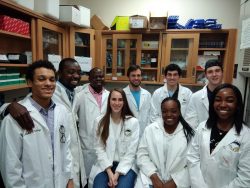 Dr. Worlanyo Eric Gato is an Associate Professor in the Department of Chemistry and Biochemistry at Georgia Southern. He teaches Biochemistry for the department and conducts research in the field of diabetes, environmental chemistry and toxicology.
Dr. Worlanyo Eric Gato is an Associate Professor in the Department of Chemistry and Biochemistry at Georgia Southern. He teaches Biochemistry for the department and conducts research in the field of diabetes, environmental chemistry and toxicology.
His main studies are centered on diabetes prevention and insulin resistance due to exposure from polycyclic aromatic hydrocarbons (PAHs). One PAH in particular, 2-aminoanthracene (2-AA), is a widely known a dietary environmental contaminant found in agricultural products, cooked meats, plastics and dyes. Undergraduate researchers in the Gato group are investigating whether gestational exposure of 2-AA will result in offsprings being more susceptible to developing type 1 (T1D) and type 2 diabetes (T2D) in rodent models. Since diabetes is caused by the inability of the pancreas to either produce or secrete insulin, or efficiently use insulin, the Gato group is currently assessing the effects of 2-AA on pancreatic beta islets. They use transcriptomic, genomic, immunohistochemical staining and clinical chemistry techniques to study the regulation of insulin and adipose tissue dysregulation using rat models to better understand and explain the effects of PAHs on diabetes. Dr. Gato also works on collaborative projects with faculty of various backgrounds. For instance, he is collaborating with Dr. Wu to investigate the toxicological effects of synthesized engineered nanomaterials (titanium dioxide nanofiber), and with Drs. Quirino and Sittaramane to assess the use of carbon nanotubes (CNT) in cancer therapy. Additionally, he is part of the Akwaaba Study Abroad program in Ghana with faculty from Public Health. Through this program students gain experience about the public health infrastructure in West Africa. Whether in the classroom or in the research lab, Dr. Gato is strong on mentorship. He actively participates in CEMITURE, the department’s NSF-REU program, where undergraduate researchers from other institutions complete ten weeks of research at GS. Both, his GS researchers and interns have presented their work and won awards at various national conferences, particularly NOBCChE and society of Toxicology. Utilizing CEMITURE’s SciWrite guidelines, Dr. Gato encourages his interns to write manuscripts, some of which have already been published and others currently under review.
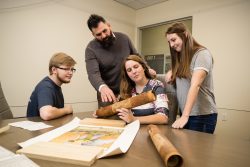 Dr. Brian K. Feltman is an Associate Professor in the Department of History. His current research project is titled “Sacrifice on Display: The Visual Culture of Death and Commemoration in First World War Germany.”
Dr. Brian K. Feltman is an Associate Professor in the Department of History. His current research project is titled “Sacrifice on Display: The Visual Culture of Death and Commemoration in First World War Germany.”
Nearly two million German soldiers perished during the First World War, and authorities used visual imagery to shape public perceptions of the fallen. The family of every fallen soldier received a customized artistic print to display in their home. These prints were intended to recognize the families’ sacrifices and encourage Germans to see the fallen as heroes rather than victims. However, visual analysis alone is not sufficient to reveal the significance of these and other wartime images.
With a Research Grant from the German Academic Exchange Service (DAAD) and a Researcher Reunion Grant from the Universität zu Köln in Cologne, Germany, Dr. Feltman has conducted archival research in more than a dozen German local, state, and federal archives. An examination of archival correspondence demonstrates that Germans reacted to the reception of commemorative prints with emotions that ranged from anger to gratitude. Although the German military sought to control representations of the fallen, private industries designed and produced memorial prints and plaques as well. Accordingly, there were significant tensions between government officials and commercial producers concerning who maintained the right to shape the image of the fallen soldier.
The ways that Germans commemorated the dead helped shape their memories of the First World War and their perception of its meaning. With the research for this project nearing completion, Dr. Feltman is writing a monograph that will be guided by two central questions: What did commemorative materials mean for the Germans who created and displayed them, and what can an analysis of the material and visual culture of mourning reveal about perceptions of the First World War?
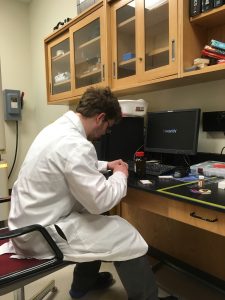
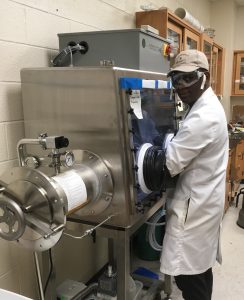 Ji Wu, PhD, Associate Professor of Analytical/Materials Chemistry
Ji Wu, PhD, Associate Professor of Analytical/Materials Chemistry
The transition from nonrenewable and environmentally unfriendly energy (fossil fuel) to sustainable but intermittent power sources (solar, wind, tidal, etc.) depends on the availability of efficient energy storage capability. The wider adoption of electric vehicles and mobile electronics also demands the development of more capable energy storage devices. Presently it is the lithium ion battery (LIB) that best satisfies these needs but with limitations, specifically: 1) energy capacity, 2) performance, 3) safety, and 4) cost. In this regard, high capacity LIB anodes like silicon and tin dioxide can play an important role. However, these high capacity electrodes can undergo roughly 300% volume change during the cycling process, which can lead to pulverization, unstable solid-electrolyte interphase, and rapid capacity loss. Our laboratory is dedicated to addressing these scientific challenges using readily available materials (silicon and tin dioxide) in novel structural forms called asymmetric membranes. The project’s objectives are: (1) to fabricate carbonized Si and SnO2 asymmetric membrane electrodes using a scalable, self-assembling, phase-inversion method that has been successfully commercialized for water purification; 2) to test their electrochemical performance, and (3) to investigate the evolution of their composition, morphology, solid-electrolyte interphase and structures during repeated charging/discharging process using a variety of characterization techniques. The success of this project will lead to the transformative change in the design of LIBs and boost the dynamic growth of green energy and electric vehicle industry. Existing successful programs at Georgia Southern University will be utilized to broaden the educational impact and provide research experience for both undergraduate and graduate students. This project is currently supported by National Science Foundation under award no. 1800619 and entitled ‘Asymmetric Membranes for High Capacity Lithium Ion Battery Anodes’. Multiple research papers with GS students listed as co-authors have been published in high profile journals of electrochemistry and materials science.
 Dr. Michael Pemberton, Professor of Writing & Linguistics, co-Principal Investigator on a five-year NSF-funded research study into the ethics of text recycling (sometimes referred to as “self-plagiarism”) in the STEM fields.
Dr. Michael Pemberton, Professor of Writing & Linguistics, co-Principal Investigator on a five-year NSF-funded research study into the ethics of text recycling (sometimes referred to as “self-plagiarism”) in the STEM fields.
This study, currently in its second year, is incorporating national surveys, interviews with disciplinary gatekeepers, focus groups, corpus analyses of published scientific articles, and research into copyright law in order to (1) document the extent to which such recycling occurs in published work, (2) identify the rhetorical sections where recycling most often takes place, (3) describe the ethical frameworks disciplines employ to determine when and where such recycling is acceptable or unacceptable, and (4) develop educational materials to help disciplinary specialists make informed decisions about whether or not to recycle portions of their own previously published work. The results of this research have been presented at the International Writing across the Curriculum Conference, the Conference on College Composition and Communication, and the International Writing Centers Conference, and an article about the survey portion of this research, “Attitudes toward Text Recycling in Academic Writing across Disciplines,” was recently published in the journal, Accountability in Research: Policies and Quality Assurance (DOI: 10.1080/08989621.2018.1434622).
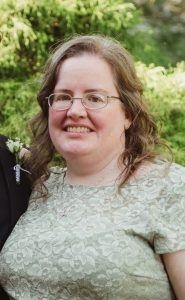 Dr. Kathleen M. Comerford, Professor of History, Georgia Southern University, Associate Editor, Journal of Jesuit Studies
Dr. Kathleen M. Comerford, Professor of History, Georgia Southern University, Associate Editor, Journal of Jesuit Studies
In 2018, Dr. Comerford received a Princeton University Library Visiting Research Fellowship (three weeks in residence, grant of $3,000 plus travel expenses, for a total of $3,395). In 2016, she won a Yale University Beinecke Library Visiting Research Fellowship (five weeks in residence, $4,000). Both of these grants supported the ongoing European Jesuit Libraries Provenance Project, a multimedia undertaking which investigates the ownership and use of books held by the Society of Jesus between the 1540s and 1770s. The Jesuits are a religious order of priests, dedicated to missionary and educational work, founded in Rome in 1540. They influenced teaching, architecture, music, and religious practice around the world, but their relationship to books and libraries is under-explored. The purpose of the Project is intellectual (history of the book, history of readership, history of education) and cultural (global history, history of missions, history of material culture and collecting). Dr. Comerford is collecting photographs, books which have Jesuit ownership markings, and have applied for further funding. In August 2018, with the help of a graduate research assistant, she created a social media presence for the Project. A second part of the Project is data-driven: a database containing information on over 2,500 individual books known to have been held by a Jesuit library in Europe between the 1540s and 1770s. That is available at the website (www.jesuit-libraries.com, which links to the Facebook, Instagram and Flickr pages). Viewers can open, browse, and sort the database, where they can find information on authorship, printing, subjects, Jesuit provenance, and current location. The database is updated periodically, with a goal of uploading at least one revision (new data as well as corrections) per month. Their research will be featured in an upcoming blog on https://histoirelivre.hypotheses.org, a website dedicated to the history of the book and hosted by the French National Center for Scientific Research (CNRS), and our following on social media, while small, is international.
Last updated: 4/1/2022
